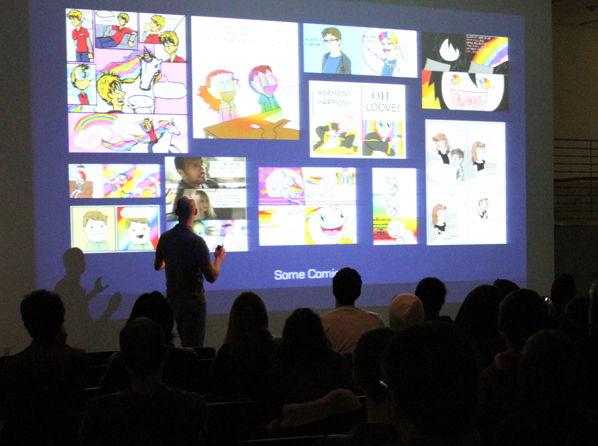Interview with Cactusquid
Posted on April 20th, 2011 by David Elliot
Jonatan Söderström, an award-winning game designer better known as Cactus of cactusquid.com, is known for his frenetic working style – he tends to work very intensely on one project for a relatively short time before moving on to the next. His method usually results in short and very unpredictable games, combining throwback 8-bit style and simplicity with wild experimentation in narrative and game expectations.
Here Cactus tells us about his background, his goals, and his thoughts on the current state of independent game design.
* * * * *
Was game design your first creative outlet?
No, I think the first creative outlet for me was drawing stuff as a kid, from random pictures to short comics. Nothing memorable, though. Then I moved on to music, and I tried doing a short film in high school. Music was a lot of fun, but it was hard to get any attention since music attracts a lot of different people, and in a lot of ways music isn’t even about being creative but rather about getting attention. By that I mean that a lot of musicians are more interested in bragging about their technical skills (kind of like a sport), to get laid or for other social reasons, and not really because they want to create.
I’m the same when it comes to games, to a big extent. I make games because I want people to give me their attention, but at the same time I do have creative visions and urges that are satisfied by what I do.
You’ve said in the past that you seek out entertainment that is alien to you, that makes you feel weird or puts you in someone else’s head. What kind of effects do you hope to create for players of your own games?
Pretty much the same effects you mentioned. But I haven’t been doing a very good job of it. I do make games that are kind of strange, but largely in a very superficial way. They have a weird element, but that element is often not explored to any bigger extent, and not as much in focus as I would’ve actually preferred.
You’re a very prolific creator and some of your shorter games get overlooked. How do you feel that games like Space Fuck, Stench Mechanics, Stallions in America, and This is Infinity, which all do something very unique, fit into your whole body of work? Or are these games just individual experiments?
Out of those games, I think This is Infinity is the strongest title. But again, I failed in all of these to create a truly compelling experience. I should’ve spent more time with Stench Mechanics to give it a good story, but I decided to release the competition version, which was made in just two days and left both “puzzles” and the story to be mediocre at best. Stallions in America I made in six hours, and I think the context in which the game took place could’ve been made a lot more interesting if I had developed some kind of actual significance to it. Space Fuck is pretty naive and probably didn’t have much more potential beyond what I did with it. I could’ve spent some time to actually make it feel right, as that is the only place where it fails.
You mentioned in another interview a while ago that you wished there were more games with sophisticated stories targeted towards adults. Are you seeing that anywhere today?
To be completely honest, no. The only games I’ve played that have had intellectually stimulating stories for me were La La Land 2 & 3. They weren’t exactly intelligent games, but they shocked me and changed my view on games forever. In both games you are forced through a sequence of events that you have no actual possibility of affecting at all, but they would be extremely ineffective if you weren’t the one prodding the character on the screen to move and make the choices that he in no way can escape anyhow.
There are other games where the creator puts rather standard gameplay concepts into interesting contexts or infuses clever plots, though. I think the short text blurbs in Flywrench in between planets really give the game something special, and Space Funeral has this amazing atmosphere that comes from the character traits, environment, music and nature of the dialogue.
I think a lot of independent game designers right now are underestimating the power of context. Many people who make games think that gameplay is the only thing important when it comes to games. But that is simply not true.
There are many examples that show this, for instance Harpooned by monoRAIL, a pretty normal shoot ‘em up that made it onto the national news because it was put into the context of whaling. Personally, I don’t find this very interesting, but it’s nonetheless an accomplishment. I think you can employ similar tactics to make the player find more personal interest in the game, which is seen in a lot of mainstream games. However, these themes and contexts are usually very broad, so that they can catch the attention of millions of people.
What I want to see is smaller games catering to niche audiences, so that instead of creating a game that a lot of people can find something to like in, you create a game that a fewer amount of people will find truly compelling in a life altering way.
Basically, what is more interesting: pushing a button if you are told that it will score you a point in the game you’re playing, or that it will cause someone to die? Both actions are the same, and both results are illusions, so why do they feel so different?
* * * * *
Play the games at cactusquid.com.








